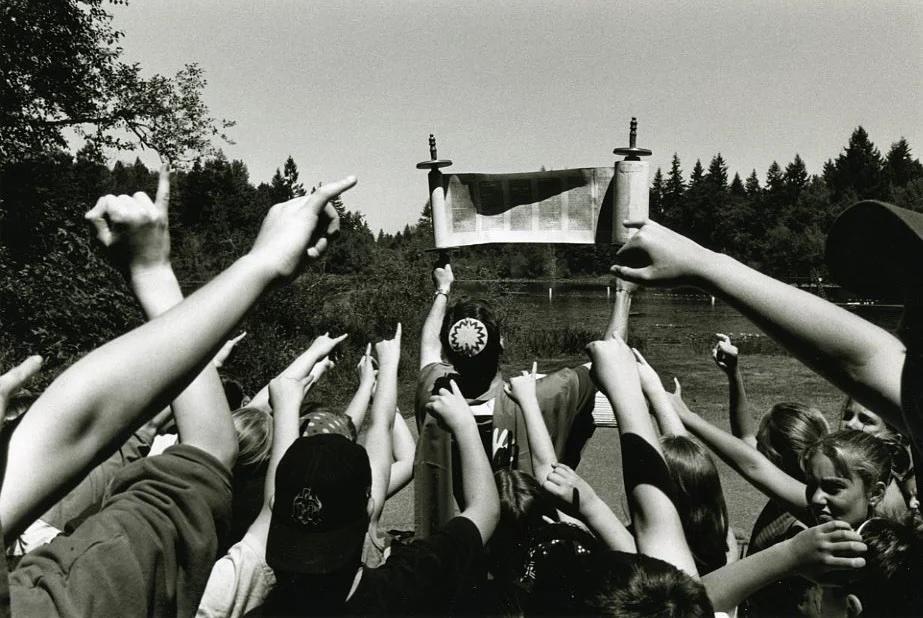The content and images in this curriculum and presentation are copyrighted and trademarked. Photographs’ subject matter is divided into categories. All photographs are by Zion Ozeri. You may only use the presentation or parts of it while implementing the DiverCity Lens in your school. For any other use, including reproduction, you must get special permission from Zion Ozeri. The use of the following content, which may be objectionable, is at your own risk, and Zion Ozeri holds no responsibility to evaluate the accuracy, completeness, and usefulness of any content provided, prior to your use. You may contact Zion Ozeri for any questions: zion@zionozeri.com
Revelation at Sinai
Lesson Plan by Zion Ozeri and Josh Feinberg

Summer Camp, Washington State, USA, 20024
All images © Zion Ozeri. All Rights Reserved.
Look closely at this photograph:
- What do you think is happening in this picture?
- Notice the gesture the kids are making toward the Torah. How do you interpret this gesture? What does it suggest or signify to you?
- Where is the photographer located in relation to the Torah (and the kids)? Why do you think the photographer might have chosen this perspective for his photograph? What effect does it have?
- How does the physical setting of the scene affect the impact or message of the photograph?
- What does this photograph suggest to you about the relationship between the people and the Torah? Does the photograph reflect aspects of your own relationship with the Torah? Why or why not?
Now read the following texts:
Exodus 19:18-20
Now Mount Sinai was all in smoke, for GOD had come down upon it in fire; the smoke rose like the smoke of a kiln, and the whole mountain trembled violently. The blare of the horn grew louder and louder. As Moses spoke, God answered him in thunder. GOD came down upon Mount Sinai, on the top of the mountain, and GOD called Moses to the top of the mountain and Moses went up.
God giving the Ten Commandments to Moses on Mount Sinai is described as a moment that was powerful and even a little terrifying. There was thunder and lightning and smoke, and then Moses came down from the mountain with the tablets. Heres what the Torah says happened shortly after the commandments were given:
Exodus 24:7
Then he (Moses) took the record of the covenant and read it aloud to the people. And they said, All that GOD has spoken we will faithfully do!
Discuss:
- Why do you think that theres such a dramatic scene surrounding the giving of the ten commandments at Mount Sinai? Why so much noise and light?
- Why do you think the people of Israel agree to faithfully obey all the laws that they were given?
- The laws are described as a covenant, because they represent an agreement between God and the people about how the people will behave. What rules or laws have you agreed to follow in your life, and why?
- Which of the ten commandments can you list? Which ones do you think have the most impact on Jewish life today?
- If you were to create a list of the top ten rules of Judaism, what would be on your list, and why?
Now revisit the photograph and text together:
- How does this text relate to the photograph?
- How is the photograph different from the image painted by the text (in terms of action, mood, setting, etc.)? How are the photograph and text similar?
- Do you think our relationship with the Torah has changed since Biblical times? Whats different? What has stayed the same?
- Do you think the way we relate physically toward the Torah and its laws can influence the way we think or feel about them? Why or why not?
Follow-up activities:
- Actually create your list of top ten rules of Judaism. Share your list with other students in small groups. How are your lists similar or different? How do your lists differ from the Ten Commandments in the Torah? Where do you think these differences come from?
- Choose one of your top ten rules of Judaism to illustrate in a photograph. The photograph can be candid, posed, or staged. Think carefully about how you want to communicate the commandment or rule for example, by showing individuals faithfully obeying it, or by representing the negative effects of disobeying. Find a quote from the Torah to go along with and support your photograph.
- Create a torn-paper collage to illustrate the moment of revelation as described in the Biblical quote above. Using only colored construction paper and glue (no markers or scissors), try to capture the events and emotions of the Biblical account as you perceive them. Share your work with the class.
For Further Research:
Mount Sinai - Jewish Virtual Library
The Ten Commandments - Jewish Education By Design
At Mount Sinai - Jewish Education By Design
